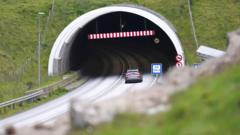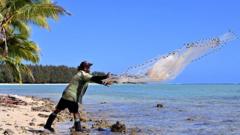Shetland Islands Council proposes modern infrastructure inspired by successful tunnel networks in the Faroe Islands to enhance connectivity and economic growth.
**Undersea Tunnels: A New Transportation Vision for Shetland Islands**

**Undersea Tunnels: A New Transportation Vision for Shetland Islands**
Experts advocate for transformative underwater tunnels as a solution to Shetland's transport woes.
The Shetland Islands are contemplating transformative infrastructure changes, inspired by the well-established tunnel networks of the Faroe Islands. Prime Minister Aksel Johannesen of the Faroes has emphasized the potential benefits of replacing outdated ferry systems with undersea tunnels to boost transportation and economic growth on the archipelago. Shetland Islands Council is actively pursuing plans to establish tunnels to connect four outlying islands, notably Unst. The proposed multi-million-pound project could utilize a financing model based on borrowing and tolls, reminiscent of the Faroese approach.
Johannesen highlighted that improvements in infrastructure have supported growth in the Faroes, where 23 tunnels now interlink 18 islands, bolstering both their population and economy. In comparison, critics in Scotland have voiced frustrations over long-standing discussions with no concrete progress on similar initiatives in Shetland.
Anne Anderson of Scottish Sea Farms, a significant employer on the islands, pointed out the urgent need for infrastructure investments to sustain the salmon industry's competitive edge, as sales have dwindled over the past decade. "The UK should adopt strategies that work for them in the Faroes and implement them here," Anderson urged.
Since the 1960s, tunnels have been a staple of Faroese progress, connecting communities in a region where geographical challenges make viable transportation crucial. The architecture of these tunnels, including the world's only undersea roundabout, has contributed significantly to the Faroese economy, allowing residents to thrive while commuting to labor markets.
On the social front, Prof. Erika Anne Hayfield from the University of the Faroe Islands noted that tunnels facilitate living in smaller communities while remaining interconnected with larger urban centers. However, concerns about infrastructure funding remain, with some Faroese arguing that tunnel costs detract from investments in schools and healthcare.
Shetland is home to crucial industries like fishing, and advocates like Council Leader Emma Macdonald stress that establishing tunnels will redefine opportunities. Notably, a feasibility study has already been approved to explore tunnel connections to Unst, Yell, Bressay, and Whalsay, with the anticipation of adopting tolling strategies similar to those used in the Faroes.
The need for improved transport links is pressing, with the current aging ferry fleet struggling to meet demand. Though Shetland's residents have not openly resisted the idea of tolls, local businesses and officials agree that a tolling strategy would be a fair compromise given current ferry survival rates.
Public sentiment appears to be shifting, with some residents, like Pat Burns, who initially expressed skepticism about tunnels, now recognizing their necessity to mitigate supply chain disruptions caused by unreliable weather and ferry schedules.
As discussions progress in Shetland, echoes of the Faroes' success serve as an inspiration to reimagine the islands’ future connectivity.
Johannesen highlighted that improvements in infrastructure have supported growth in the Faroes, where 23 tunnels now interlink 18 islands, bolstering both their population and economy. In comparison, critics in Scotland have voiced frustrations over long-standing discussions with no concrete progress on similar initiatives in Shetland.
Anne Anderson of Scottish Sea Farms, a significant employer on the islands, pointed out the urgent need for infrastructure investments to sustain the salmon industry's competitive edge, as sales have dwindled over the past decade. "The UK should adopt strategies that work for them in the Faroes and implement them here," Anderson urged.
Since the 1960s, tunnels have been a staple of Faroese progress, connecting communities in a region where geographical challenges make viable transportation crucial. The architecture of these tunnels, including the world's only undersea roundabout, has contributed significantly to the Faroese economy, allowing residents to thrive while commuting to labor markets.
On the social front, Prof. Erika Anne Hayfield from the University of the Faroe Islands noted that tunnels facilitate living in smaller communities while remaining interconnected with larger urban centers. However, concerns about infrastructure funding remain, with some Faroese arguing that tunnel costs detract from investments in schools and healthcare.
Shetland is home to crucial industries like fishing, and advocates like Council Leader Emma Macdonald stress that establishing tunnels will redefine opportunities. Notably, a feasibility study has already been approved to explore tunnel connections to Unst, Yell, Bressay, and Whalsay, with the anticipation of adopting tolling strategies similar to those used in the Faroes.
The need for improved transport links is pressing, with the current aging ferry fleet struggling to meet demand. Though Shetland's residents have not openly resisted the idea of tolls, local businesses and officials agree that a tolling strategy would be a fair compromise given current ferry survival rates.
Public sentiment appears to be shifting, with some residents, like Pat Burns, who initially expressed skepticism about tunnels, now recognizing their necessity to mitigate supply chain disruptions caused by unreliable weather and ferry schedules.
As discussions progress in Shetland, echoes of the Faroes' success serve as an inspiration to reimagine the islands’ future connectivity.




















